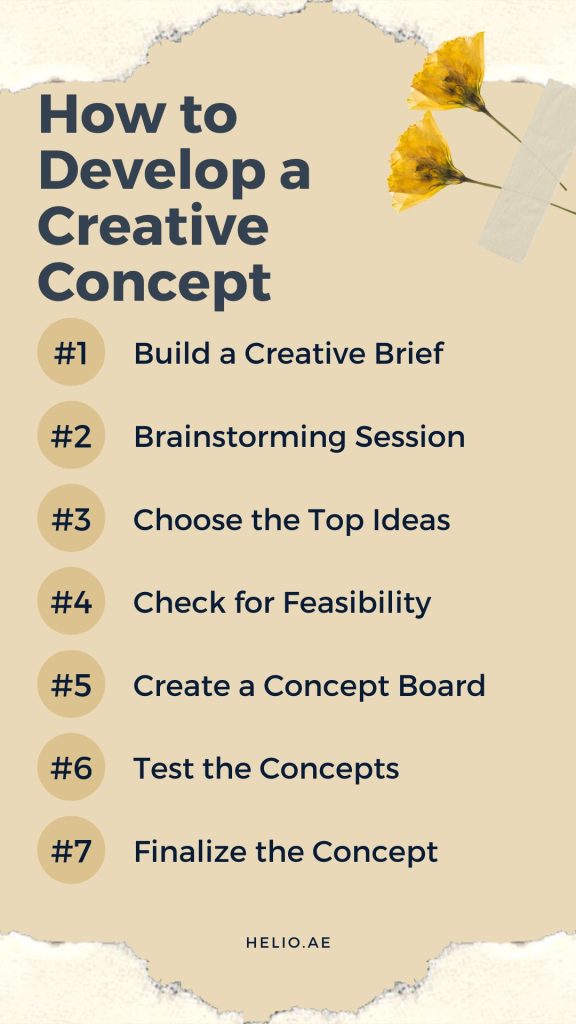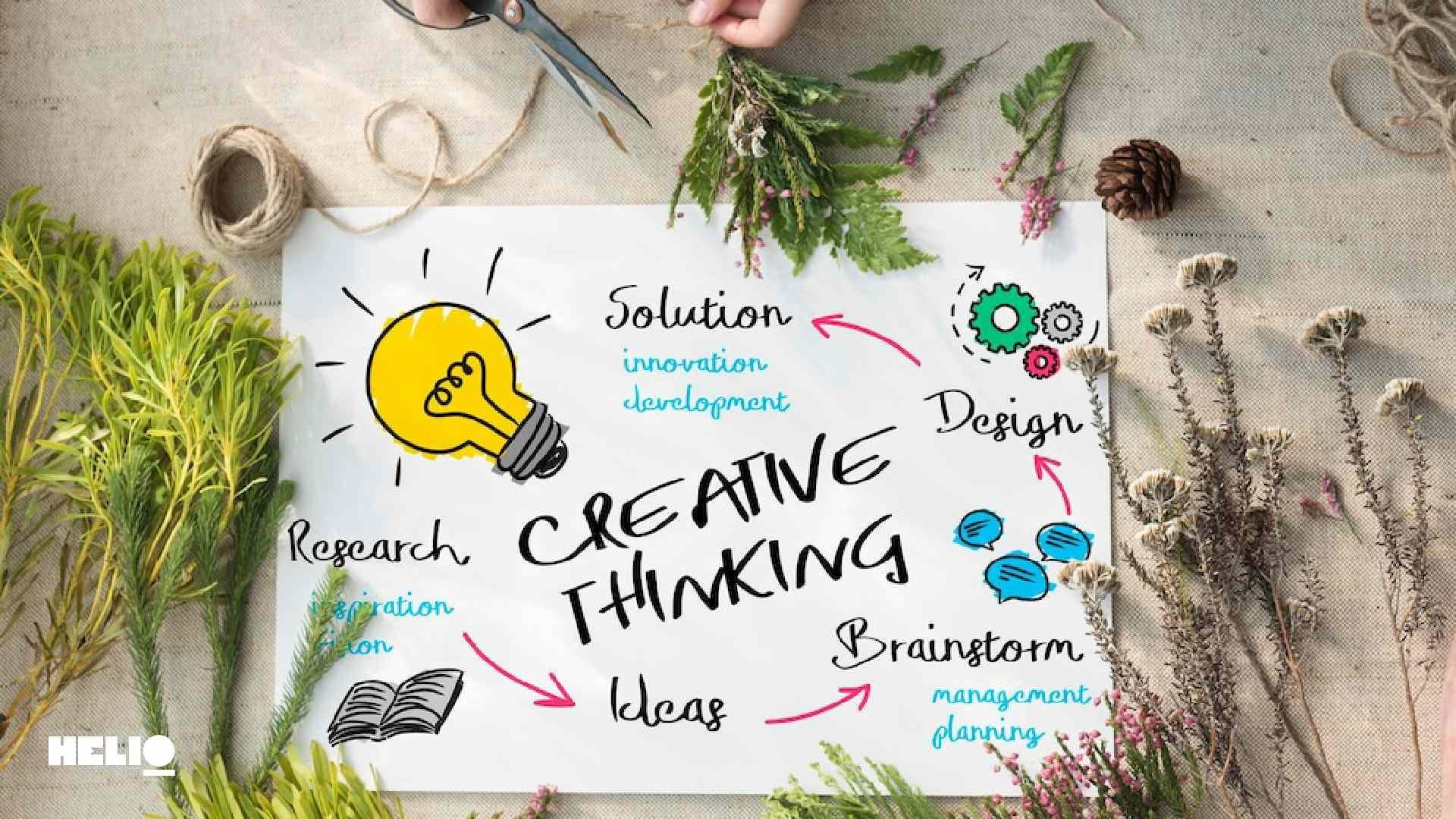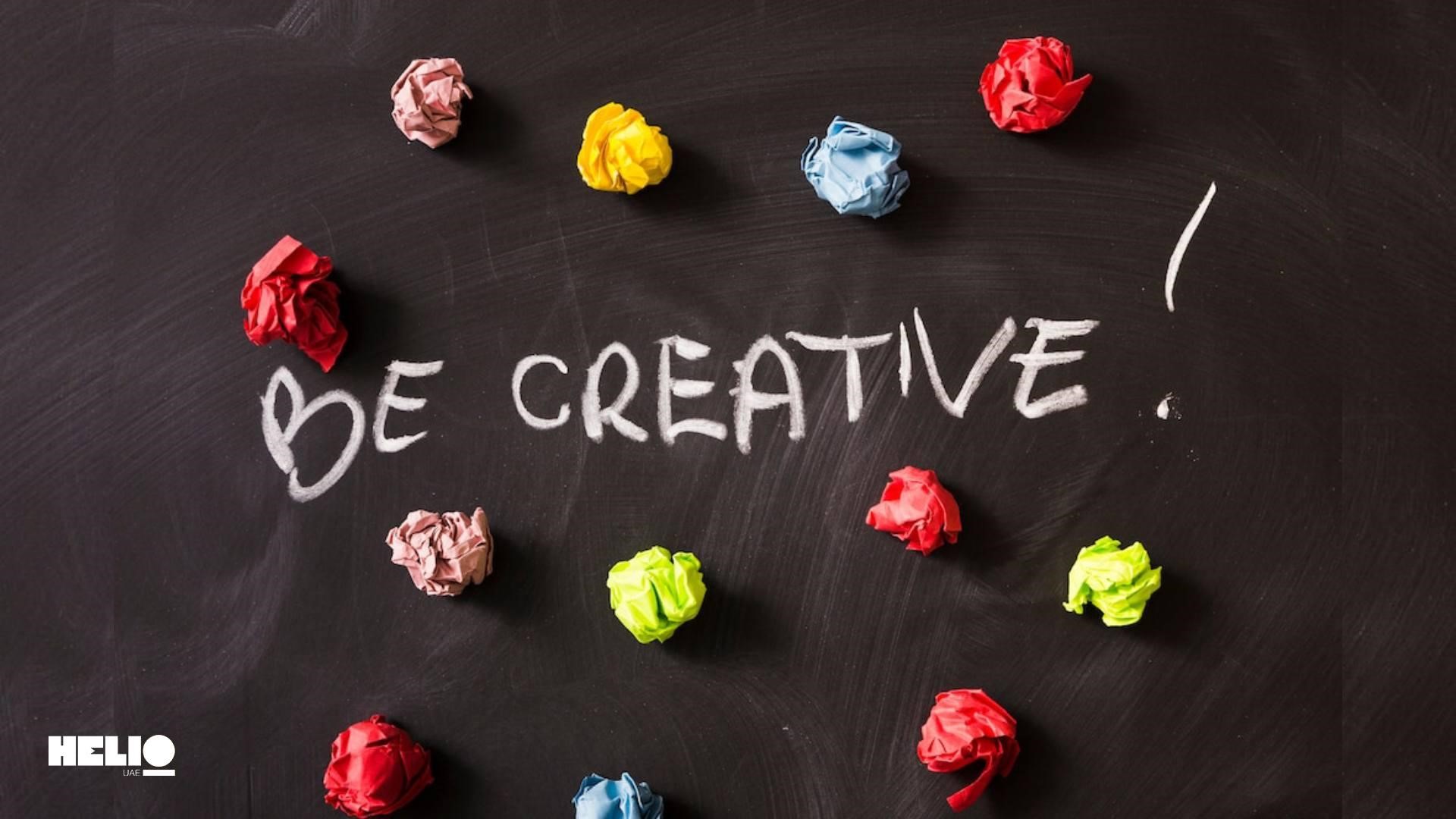Listen to this blog post:
The ability to develop groundbreaking concepts is a valuable skill in marketing scope. But what exactly is a creative concept, and how can you ensure that your ideas take flight? This post from Helio will explore the heart of creative concept development, offering insights into what works—and what doesn’t—while equipping you with proven strategies to transform your visions into reality.
If you’re a designer, creative professional, or marketing team member in the UAE, this guide provided by Helio advertising agency, featuring creative strategies for concept development, will serve as your roadmap to mastering the art of concept development, enhancing your team’s innovation capabilities along the way.
What is a Creative Concept?
A creative concept is the backbone of any successful campaign or project. It’s the core idea that brings cohesion and direction to your work. But it’s more than just a spark of inspiration; a strong creative concept offers clarity, guiding the creative process and ensuring that every element aligns with the project’s goals.
At its essence, a creative concept presents the foundation upon which all creative work is built. It ensures that visual elements, messaging, and execution stay true to the overall vision, creating a consistent and unified expression. A well-developed concept resonates with audiences, capturing their attention and leaving a lasting impression.
Crafting a creative concept reqiuires a balance of imagination and strategy. It must be innovative yet feasible, pushing boundaries while remaining achievable. By combining creativity with practicality, you create concepts that inspire and drive results.
What is NOT a Creative Concept?
It’s important to understand what constitutes a creative concept and what doesn’t. Confusion often arises when ideas are mistaken for concepts. An idea is simply the seed of creativity, a thought or notion that has yet to be fully developed or refined.
On the other hand, a creative concept is a fully realized vision. It transforms an initial idea into a concrete plan, complete with guidelines for execution. While ideas are plentiful, developing them into viable concepts requires careful thought and consideration.
A common misconception is that a creative concept is merely a tagline or a slogan. While these elements may be part of the concept, they are not the concept itself. Instead, the concept encompasses the overarching theme and message, providing a framework for content and design.
For instance brands in fashion industry are leveraging Cgi advertising for fashion industry examples to create stunning virtual runway shows, hyper-realistic digital models, and immersive 3D campaigns.
How to Develop a Creative Concept
Creating a compelling creative concept involves several key steps ensuring innovation and feasibility. Following these steps, you can transform ideas into powerful concepts that captivate and engage your audience.
If you need help, hiring a professional video production company in dubai, like Helio, would be an option.
1. Build a Creative Brief
The first step in developing a creative concept is to build a comprehensive creative brief. This document outlines the project’s objectives, target audience, key messages, and desired outcomes. It serves as a roadmap, guiding the creative process and providing clarity to all team members involved.
A well-crafted creative brief ensures that everyone is on the same page. It outlines the project’s parameters, constraints, and opportunities, allowing for a focused approach to concept development. Establishing a clear direction from the start sets the foundation for a successful outcome.
The creative brief provides guidance and encourages collaboration and input from various stakeholders. It allows for open communication and helps identify potential challenges early, ensuring a smoother development process.

2. Select the Brainstorm Team and Host a Brainstorming Session
Once you have a creative brief in place, it’s time to assemble your brainstorming team. Select individuals with diverse skills and perspectives to foster a collaborative and dynamic environment. This diversity encourages sharing fresh ideas, leading to more innovative concepts.
During the brainstorming session, encourage open dialogue and exploration of ideas. Create a safe space where team members feel comfortable expressing their thoughts, no matter how unconventional they may seem. This openness can lead to unexpected breakthroughs and innovative solutions.
Set clear goals and guidelines to maximize the session’s effectiveness. Encourage active participation from all team members and capture ideas for further exploration. This structured yet collaborative approach ensures that valuable insights are noticed.
3. Choose the Top Ideas and Expand Them
After your brainstorming session, review and evaluate the ideas generated. Identify the most promising ones and select the top contenders for further development. This step involves assessing each idea’s potential, feasibility, and alignment with the project’s goals.
Once you have identified the top ideas, expand upon them to create detailed concepts. Consider how each idea can evolve into a comprehensive vision. This process involves adding layers of depth, refining key messages, and exploring different angles.
Expanding ideas requires creativity and critical thinking. It’s an opportunity to push boundaries and explore new possibilities. By thoroughly developing your chosen ideas, you can create compelling concepts that resonate with your audience.
4. Check for Feasibility
While creativity is essential in concept development, feasibility is equally important. Assess the practicality of each concept by considering factors such as budget, resources, and timeline. This evaluation ensures your ideas can be executed successfully within the project’s constraints.
Feasibility doesn’t mean compromising creativity; it involves finding innovative solutions that align with practical considerations. It’s about striking a balance between ambition and realism, creating inspiring and executable concepts.
By conducting a feasibility check early in the process, you can identify potential challenges and address them proactively. This foresight minimizes risks and increases the likelihood of successful implementation.

5. Prepare Visual Presentations of Concepts – Create a Concept Board
Visual presentations are powerful tools for conveying your creative concepts. They represent your ideas visually, allowing stakeholders to visualize the final outcome. Creating a concept board is an effective way to showcase your vision and gain buy-in from decision-makers.
A concept board typically includes visual elements such as sketches, images, and mood boards. These elements capture the essence of the concept, evoking emotions and conveying the intended message. Additionally, incorporate key messages and supporting text to provide context and clarity.
When preparing visual presentations, ensure they align with the project’s goals and objectives. Use them to communicate your vision effectively and inspire stakeholders to support your concept.
For example, understanding what is video marketing can help you effectively present your concepts through engaging video content. Video marketing allows you to visually communicate your ideas, making them more impactful and memorable for your audience.
6. Test the Concepts
Testing is a crucial step in the concept development process. It allows you to gather feedback and validate your ideas before implementing them. By testing your concepts, you can identify strengths and weaknesses and make informed decisions about how to proceed.
Depending on the project’s nature, various methods are available for testing concepts. These may include focus groups, surveys, prototypes, or pilot programs. Each method provides valuable insights from different perspectives, helping you refine and enhance your concepts.
By incorporating feedback from testing, you can improve the effectiveness and impact of your concepts. Testing also provides an opportunity to address any concerns or challenges, ensuring a smoother transition from idea to execution.

7. Select and Finalize the Concept
The final step in the concept development process is selecting and finalizing the concept. After testing and gathering feedback, it’s time to decide which concept to proceed with. Consider all available information and weigh the potential benefits and risks.
Once you have selected the concept, finalize it by refining the details and addressing any remaining concerns. This step involves fine-tuning the messaging, visual elements, and overall execution plan. Ensure the finalized concept aligns with the project’s objectives and stakeholder expectations.
Finalizing the concept also involves gaining approval from key stakeholders. Communicate the value and potential impact of the chosen concept, highlighting its alignment with the project’s goals. This step ensures that everyone is on board and ready to move forward.
| Step | What It Involves | Key Questions | Why It Matters |
|---|---|---|---|
| Define Objectives | Set clear goals and project parameters. | What are the project’s purpose, audience, and desired outcomes? | Ensures focus and alignment with your overall strategy. |
| Build a Creative Brief | Outline key project details, including goals, audience, and constraints. | Does the brief provide clear guidance for the team? | Provides a roadmap to keep everyone aligned during development. |
| Brainstorm Ideas | Gather diverse team members to generate ideas collaboratively. | Are the ideas innovative, and do they align with project goals? | Encourages creativity and leads to innovative solutions. |
| Expand and Refine Ideas | Develop top ideas into detailed concepts with depth and structure. | Are the concepts practical and aligned with objectives? | Transforms raw ideas into actionable, impactful concepts. |
| Check Feasibility | Assess budget, timeline, and resource requirements for each concept. | Can the concept be realistically executed? | Balances creativity with practical constraints to ensure success. |
| Create Visual Presentations | Use concept boards, sketches, and visuals to communicate ideas. | Do the visuals clearly convey the concept and its impact? | Helps stakeholders visualize the concept and facilitates buy-in. |
| Test Concepts | Use focus groups, surveys, or prototypes to gather feedback. | What do stakeholders and users think of the concept? | Validates concepts and identifies areas for improvement before finalization. |
| Select and Finalize | Choose the best concept based on feedback, feasibility, and alignment with objectives. | Does the concept meet goals and resonate with the audience? | Ensures the final concept is impactful and ready for execution. |
| Iterate and Evolve | Continuously refine ideas based on testing and feedback. | Can the concept be improved further? | Encourages continuous improvement to achieve optimal results. |
| Document and Evaluate | Maintain records of the process and evaluate successes and challenges. | What lessons can be applied to future projects? | Builds institutional knowledge and improves future concept development efforts. |
Best Practices for Concept Development – Creative Concept Development Strategies
Consider implementing these best practices to enhance your creative concept development process. By following these strategies, you can foster a culture of innovation and create impactful concepts that drive success.
1. Foster a Collaborative Environment
Collaboration is key to successful concept development. Encourage open communication and collaboration among team members, fostering a culture of creativity and innovation. Leveraging diverse perspectives and expertise can generate more innovative ideas and solutions.
Create opportunities for cross-functional collaboration, bringing together individuals from different backgrounds and disciplines. This diversity of thought leads to fresh insights and unique approaches, enhancing the overall concept development process.
In addition to internal collaboration, external input and feedback should be sought. Engage with stakeholders, clients, and industry experts to gain valuable insights and broaden your perspective. This collaborative approach ensures that your concepts are well-rounded and impactful.

2. Embrace a User-Centric Approach
A user-centric approach prioritizes the needs and preferences of your target audience during concept development. Understanding your audience’s desires and pain points allows you to create concepts that resonate and deliver value.
Conduct thorough research to gain insights into your audience’s behaviors, expectations, and preferences. Use this information to inform your concept development process, ensuring that your ideas align with the needs and desires of your target audience.
By adopting a user-centric approach, you can create innovative, relevant, and impactful concepts. This focus on the end-user ensures that your concepts address real-world challenges and deliver meaningful solutions.
3. Encourage Ideation Without Constraints
Remove constraints and limitations during the initial stages of concept development to encourage free-flowing ideation. This will allow team members to think outside the box and explore unconventional ideas, fostering a culture of creativity and innovation.
Create an environment where team members feel comfortable expressing their thoughts and ideas without fear of judgment. Encourage risk-taking and experimentation, celebrating successes and failures as valuable learning opportunities.
Encouraging ideation without constraints can unlock new possibilities and discover innovative solutions. This approach empowers team members to push boundaries and challenge conventional thinking, leading to breakthrough concepts.
4. Utilize Visual Thinking Tools
Visual thinking tools are powerful aids in the concept development process. They help convey complex ideas, stimulate creativity, and facilitate collaboration. By incorporating visual elements, you can enhance communication and inspire innovative thinking.
To capture and organize ideas, use tools such as mind maps, flowcharts, and sketching. These visual representations provide clarity and structure, making it easier to identify patterns and connections. They also encourage collaboration by providing a shared visual reference for team members.
Incorporating visual thinking tools into your concept development process enhances creativity and problem-solving. They enable you to explore ideas from different angles and gain new perspectives, leading to more innovative and impactful concepts.

5. Prototype Early and Often
Prototyping is a valuable technique for testing and refining concepts. By creating prototypes early in development, you can quickly gather feedback and make informed decisions. Prototypes provide a tangible representation of your ideas, allowing for hands-on exploration and validation.
Start with low-fidelity prototypes to quickly iterate and refine your concepts. These can be simple sketches, wireframes, or mock-ups that capture the essence of your ideas. Use these prototypes to gather feedback and identify areas for improvement.
As your concepts evolve, transition to higher-fidelity prototypes that provide a more realistic representation of the final product. These prototypes allow for more comprehensive testing and validation, ensuring your concepts meet user expectations and deliver value.
6. Gather and Integrate Feedback
Feedback is a valuable resource for improving and refining your concepts. Throughout the concept development process, actively seek feedback from stakeholders, team members, and users. This input provides valuable insights and helps identify potential challenges or areas for improvement.
Create a feedback loop that encourages open communication and collaboration. Establish channels for collecting feedback, such as surveys, interviews, or regular check-ins. Ensure that feedback is constructive and actionable, providing specific suggestions for enhancement.
Integrating feedback into your concept development process can strengthen and make your concepts more impactful. This iterative approach allows you to address challenges, refine ideas, and deliver solutions that meet your audience’s needs.
7. Iterate and Evolve Ideas
Concept development is an ongoing process that requires iteration and evolution. Encourage a mindset of continuous improvement, where ideas are constantly refined and enhanced. By iterating on your concepts, you can uncover new possibilities and push the boundaries of innovation.
Challenge assumptions and explore alternative approaches to existing ideas. Use insights gained from testing and feedback to guide the evolution of your concepts. This iterative approach ensures that your concepts remain relevant and impactful in a rapidly changing landscape.
Fostering a culture of iteration and evolution can drive continuous innovation and create concepts that stand the test of time. This commitment to improvement ensures that your concepts consistently deliver value and meet the evolving needs of your audience.

8. Prioritize Feasibility and Impact
Balancing creativity with feasibility is essential in concept development. While it’s important to explore bold and innovative ideas, it’s equally crucial to consider their practicality and potential impact. By prioritizing feasibility and impact, you can ensure your concepts are inspiring and achievable.
Evaluate each concept against criteria such as budget, resources, and timeline. Assess each idea’s potential risks and benefits, making informed decisions on which concepts to pursue. This evaluation ensures that your concepts align with the project’s objectives and constraints.
By prioritizing feasibility and impact, you can focus on concepts with the greatest potential for success. This strategic approach maximizes your resources and increases the likelihood of achieving your desired outcomes.
9. Document the Process
Documenting the concept development process is essential for capturing insights, lessons learned, and best practices. Maintaining a record of your process ensures consistency, facilitates collaboration, and improves future projects.
Create a centralized repository for storing documentation, including creative briefs, meeting notes, and visual presentations. This repository is a valuable resource for team members, allowing them to access information and track progress.
In addition to documentation, regular reflection and evaluation of the concept development process should be encouraged. Identify areas for improvement and celebrate successes, ensuring that each project contributes to the growth and success of your team.
10. Stay Open to Pivot
Flexibility and adaptability are crucial in concept development. While having a plan is important, be open to pivoting and adjusting your approach as needed. You can respond to emerging trends, feedback, and new opportunities by staying open to change.
Encourage a culture of experimentation and exploration where team members feel comfortable proposing changes or adjustments. This openness allows for innovative thinking and ensures that your concepts remain relevant and impactful.
By staying open to pivot, you can seize new opportunities and create truly groundbreaking concepts. This flexibility enables you to adapt to changing circumstances and capitalize on emerging trends, ensuring continued success in a dynamic and competitive landscape.

Benefit from Helio’s Creative Strategies for Concept Development
If you’re looking to elevate your concept development process, Helio’s team of creative marketing professionals can help. Helio is an innovatiove advertising company and provides you with professional services. Contact us if you want to partner with Helio’s departments, including Helio online marketing company in uae, helio Graphic Studio dubai, helio architecture company and helio production house in dubai. Our experts have the knowledge and experience to guide you through every stage of concept development, from ideation to execution. Know more About Us to decide precisely.
Whether you’re seeking to enhance your brand’s creativity, improve engagement with your audience, or drive business growth, our innovative strategies can help you achieve your goals. Focusing on collaboration, innovation, and impact, we empower businesses to unlock their full creative potential.
Ready to take your concept development to the next level? Contact Us today to get started with Helio’s expert support and guidance.
FAQs
1. What role does user feedback play in concept development?
User feedback is invaluable in concept development. It provides insights into user preferences, pain points, and expectations, allowing you to create concepts that meet their needs. By incorporating feedback, you can refine and enhance your concepts, ensuring they deliver value and resonate with your audience.
2. How can teams avoid groupthink during concept development?
To avoid groupthink, encourage diverse perspectives and open dialogue among team members. Create an environment where individuals feel comfortable expressing their opinions and challenging assumptions. Encourage independent thinking and exploration of alternative approaches to ensure a well-rounded and innovative concept development process.
3. What are the signs that a concept is strong enough to proceed with?
A strong concept aligns with the project’s objectives, resonates with the target audience, and demonstrates feasibility. It should have clear, compelling messaging, a well-defined vision, and a cohesive execution plan. A strong concept should also demonstrate potential for impact, addressing real-world challenges and delivering meaningful solutions.
4. How many concepts should be developed before moving to prototyping?
The number of concepts to develop before prototyping depends on the project’s scope and requirements. It’s generally advisable to explore multiple concepts, allowing for comparison and evaluation. However, focus on quality rather than quantity, ensuring each concept is well-developed and aligned with the project’s goals.
5. How to select a video production company in Dubai for creative projects?
Selecting the right video production company involves evaluating their portfolio, expertise, and understanding of your creative vision. Look for companies with experience in your industry, a proven track record, and the ability to align with your budget and timelines. Clear communication and a collaborative approach are also key factors to ensure successful project execution.





